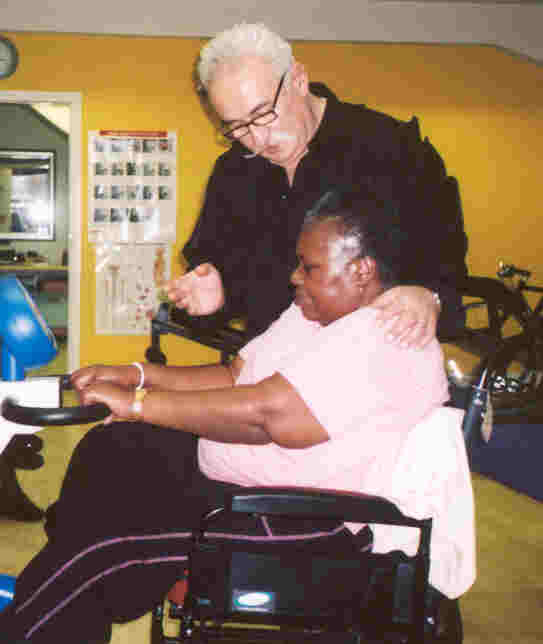MIND INSTRUCTOR
Hratch Ogaliís Mind-Instructor Clinic (London,
England) treats a variety of neurological disorders including SCI.
Although Ogali stresses rigorous strengthening exercises like other
rehabilitation programs that are emerging for SCI, the programís
foundation is based on a shift in patient consciousness. He catalyzes and
reinforces this c hange,
from the defeating ďyou will never walk againĒ and other negative,
recovery-inhibiting attitudes that are deeply imprinted in consciousness
after injury to a positive ďYeah, I will do it.Ē When this
new attitude is embedded with conviction in our consciousness - the
captain of our ship - the physical body starts to follow.
hange,
from the defeating ďyou will never walk againĒ and other negative,
recovery-inhibiting attitudes that are deeply imprinted in consciousness
after injury to a positive ďYeah, I will do it.Ē When this
new attitude is embedded with conviction in our consciousness - the
captain of our ship - the physical body starts to follow.
Ogaliís role is catalytic; he is not the healer but
metaphorically the force that opens the prison door allowing the patient
to step through if so desired. Patients heal themselves, starting from the
deepest soul level.
Then, demonstrating the neuronal adaptability (i.e.,
plasticity) scientists now believe is inherent in all, Ogali speculates
that nascent neuronal growth commences, dormant neurons turn on, and new
neuronal connections are created. Regardless of the specific intervening
physiological mechanisms, Ogali believes that physical healing stems from
the healing in consciousness, which is then reinforced through aggressive
physical rehabilitation. According to Ogali, most patients who have
persevered with his demanding program have accrued additional function,
sometimes subtle but life-enhancing and sometimes dramatic.
Recently, Ogaliís program has received extensive UK
press attention and also was the focus of a recent Discovery Health
Channel documentary Miracle Steps featuring Christopher Reeve. Much
of this media attention has revolved around Gemma, a 19-year old woman who
sustained a complete cervical C2-3 injury when she was seven in an auto
accident. After treatment by Ogali, Gemma can now initiate movement with
effort in much of her body below the injury site for the first time since
injury, including standing and taking up to 20 steps.
The role of consciousness or mind in healing has
always been troublesome for scientists. The 17th century French
philosopher Renť Descartes framed the contemporary debate on the subject
by stating that everything under the sun consists of either res
cognitas (i.e., consciousness, mind) or res extensa (i.e., physical
matter). Unlike neuroscientists who tend to equate consciousness with
brain chemistry and biology, many alternative healing traditions view the
brain more from Descartesí perspective; specifically, the brain is merely
the bodyís physical processor for consciousness. Under this view, although
possessing a good processor affects your overt intelligence, and although
outward expression of consciousness may be a function of processorís
neuronal synaptic connections, etc., it is not the site of your
consciousness anymore than your big toe.
With such beliefs, even if the brain is damaged from
severe head injury, stroke, ALS, MS, or Alzheimerís disease, the
consciousness is always whole and complete, and, relevant to Ogaliís work,
possesses the blueprint memories of our able-bodied selves that can be
accessed for healing.
However, all the disability-related negative
attitudes and emotions that may have been picked up interfere with
accessing these healing blueprints. Patients are told that they will never
walk again and any thoughts otherwise will just prevent them from getting
on with their lives. That is a tough, deeply imprinted sentence that must
be surmounted to have significant physical healing. It is like trying to
push a car in one direction (i.e., healing the physical body) when the
steering wheel (i.e., your consciousness) is cranked in another direction.
Any healing modality will work better when the steering wheel is turned in
the right direction Ė basically, Ogaliís goal.
A key program element is periodic guided meditation
sessions designed to bust apart limiting belief patterns. These mind
instructions, however, are of relatively limited value unless the patient
carries out extensive daily, reinforcing breathing, meditative, and
mental-concentration exercises, which are individually tailored to help
replace the old thinking with the new healing paradigm in the patientís
consciousness.
In addition, although Ogaliís mind instruction is
carried out on an ongoing basis, much of his program involves intense
physical exercise and conditioning. Furthermore, Ogali believes that
SCI-associated spasms should not be suppressed but exploited to stimulate
functional recovery. With this belief, patients are encouraged to
gradually wean themselves from spasticity-controlling medications, which
Ogali views as reducing the bodyís sensitivity to the mindís healing
instructions.
Although difficult to explain from a conventional
biomedical context, this Mind-Instructor program reflects healing wisdom
embraced by mankind through most of history until modern medicineís
emergence. Furthermore, most of us intuitively understand that our
consciousness, will, or mental and emotional attitudes affect the outcome
of whatever we strive for, ranging from athletic performance to
rehabilitation. Given such understanding, little of Ogali's
mind-influencing, soul-motivating, function-restoring program is truly
radical.
TOP